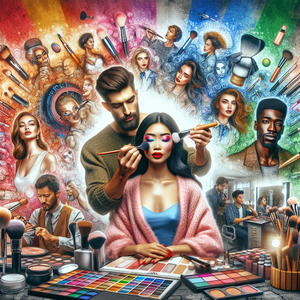
Exploring Freelance Illustration: 20 Career Paths to Ignite Your Creative Journey
Freelance illustration presents an exciting opportunity for artists who wish to express their creativity while enjoying the independence that comes with self-employment. Whether you’re just beginning or looking to elevate your existing freelance career, understanding the various roles within this vibrant industry is essential. This guide not only outlines the diverse paths available to you but also shares insights, statistics, and personal stories that highlight the nuances of thriving as a freelance illustrator.
Job Summaries:
Freelance Illustrator:
- Freelance illustrators produce visual art for a multitude of industries, from publishing to advertising.
- Success in this role hinges on exceptional drawing skills, proficiency in digital tools, and effective client communication.
- Building a personal brand and mastering contract negotiations are crucial for attracting clients and ensuring a steady workflow.
Editorial Illustrator:
- Focusing on artwork that complements articles and essays.
- Editorial illustrators partner with editors to enhance written content visually.
- A versatile style and strong conceptual abilities are vital.
- Coupled with a well-curated portfolio that showcases adaptability.
Children’s Book Illustrator:
- Vibrant artwork is the hallmark of children’s book illustrators.
- They breathe life into narratives.
- Understanding storytelling and character design is essential.
- A portfolio that highlights a unique artistic style is important.
- This is especially relevant in the expanding market.
Concept Artist:
- Concept artists craft visual representations for films and video games during the pre-production stage.
- Strong drawing skills and the ability to capture a project’s essence are paramount.
- A competitive portfolio showcasing conceptual work is indispensable.
Character Designer:
- These artists specialize in creating captivating characters across various media.
- A solid grasp of anatomy, color theory, and narrative context is essential.
- A portfolio filled with character concepts is needed to attract potential clients or employers.
Graphic Novelist:
- Merging writing and illustration, graphic novelists create compelling stories paired with engaging visuals.
- While many operate independently, collaboration with editors is common.
- A polished portfolio that reflects their storytelling capabilities is key to success.
Infographic Designer:
- Infographic designers excel at visually presenting complex information.
- This role demands strong research skills and design software proficiency to effectively communicate data.
- A background in graphic design is typically beneficial.
Comic Book Artist:
- Crafting sequential art, comic book artists need a firm understanding of narrative and character expression.
- A well-rounded portfolio showcasing completed comic pages is essential to capture the interest of potential clients.
Storyboard Artist:
- Storyboard artists define scenes for films and animations.
- Require strong drawing skills and a keen sense of visual storytelling.
- A robust portfolio of previous work can open doors in the expanding film and animation industries.
Fashion Illustrator:
- Fashion illustrators create visual representations of clothing designs.
- An understanding of current fashion trends and collaboration with designers are crucial for success.
- A standout portfolio demonstrating a unique illustrative style will attract clients.
Tattoo Artist:
- Tattoo artists bring client ideas to life through custom designs.
- Tattoo artists require artistic talent and an understanding of anatomy.
- A portfolio showcasing previous work is essential for building a successful practice.
- Knowledge of hygiene practices is essential for building a successful practice.
Medical Illustrator:
- Medical illustrators produce visual representations of medical subjects.
- They require a solid understanding of anatomy and biology.
- A degree in medical illustration or related fields is often necessary.
Motion Graphics Designer:
- These designers create animated visuals for various media.
- Necessitating strong graphic design skills and proficiency in animation software.
- A portfolio showcasing previous work is crucial to stand out in this competitive field.
Advertising Illustrator:
- Advertising illustrators generate visuals for marketing campaigns.
- They require creativity and a solid grasp of brand messaging.
- A robust portfolio featuring previous advertising work can pave the way for opportunities in this fast-paced industry.
Environmental Illustrator:
- Focusing on the beauty of natural landscapes and ecosystems.
- Environmental illustrators must possess a deep understanding of the environment.
- A portfolio of previous work is essential for attracting clients in this niche.
Product Illustrator:
- Product illustrators create visuals for consumer goods.
- They often collaborate with marketing teams.
- A degree in graphic design or illustration is typically recommended.
- A strong portfolio is essential.
Social Media Illustrator:
- These illustrators design visuals tailored for various social media platforms.
- Requiring an understanding of trends and strong graphic design skills.
- Maintaining an active social media presence can enhance visibility.
Visual Development Artist:
- Visual development artists shape the overall aesthetic of projects.
- They work on character designs and environments.
- A portfolio showcasing visual development work is critical for success in animation and film.
Scientific Illustrator:
- Tasked with creating detailed representations of scientific concepts
- Scientific illustrators need a solid grasp of scientific principles
- A degree in scientific illustration is typically required.
Art Director:
- Art directors oversee visual projects
- Require strong leadership skills
- Require a deep understanding of design principles
- A comprehensive portfolio demonstrating experience is essential for this leadership role.
The world of freelance illustration is rich with diverse opportunities, each offering unique prospects for artistic expression and professional advancement. As you explore these varied roles, remember the importance of networking, continual skill enhancement, and a clear understanding of client expectations. The potential for a fulfilling and successful career in freelance illustration is substantial, making this an exciting time to enter the field. To stay informed about current job openings and opportunities, regularly check relevant job boards and platforms. By equipping yourself with the right tools, knowledge, and a proactive mindset, you can navigate the freelance landscape effectively, ensuring that your artistic career flourishes. Personal stories from seasoned illustrators highlight that with dedication and creativity, a rewarding career path awaits you in this dynamic industry.
Explore More Jobs

